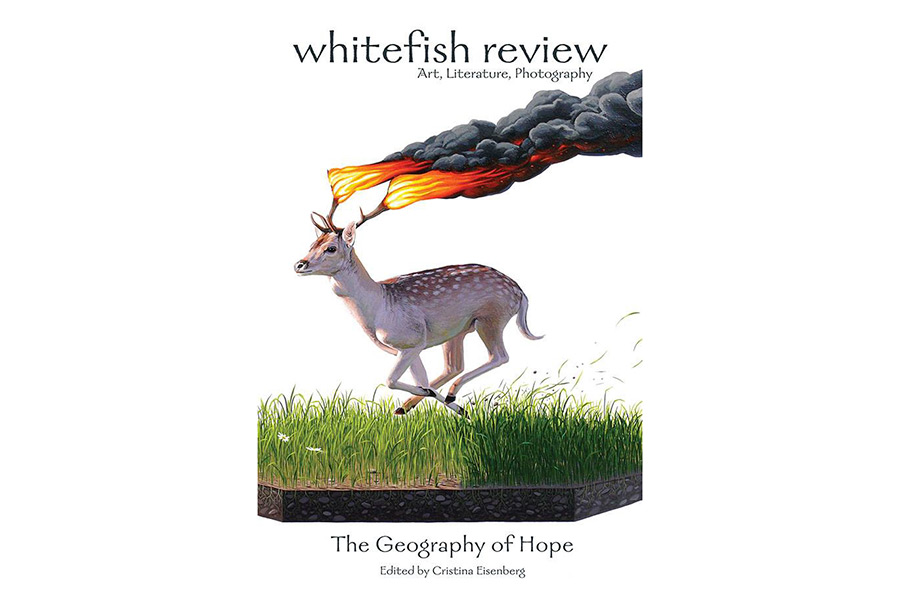Forty-four years ago, literary giant Wallace Stegner wrote a letter supporting the then-fledgling Wilderness Act. In it, Stegner expounds upon the reasons for keeping pieces of the United State wild, noting that human beings have to stay connected to the natural world.
“We simply need that wild country available to us, even if we never do more than drive to its edge and look in. For it can be a means of reassuring ourselves of our sanity as creatures, a part of the geography of hope,” Stegner wrote.
With the Wilderness Act celebrating its 50th anniversary this year, the leadership at the Whitefish Review, a nonprofit literary journal in Whitefish, took Stegner’s words to heart, making the theme of the 16th issue, “The Geography of Hope.”
The 160-page journal will be released on Dec. 13 at Casey’s in Whitefish, with doors opening at 7 p.m. and readings starting at 8 p.m.
Founding editor Brian Schott said the theme came from longtime-contributor and editor Cristina Eisenberg, who is the lead scientist at the Earthwatch Institute based at Harvard University, the author of “The Carnivore Way” and “The Wolf’s Tooth,” and one of the leading researchers in carnivore behavior.
Eisenberg started with the Whitefish Review as the nonfiction editor as well as a contributor, and edited the 16th issue while working on her third book and giving presentations across the globe on animal-human coexistence.
“She’s all over the place,” Schott said. “I think it’s incredibly special that she has carved out the time to continue to help us, and lead the charge on this one.”
Eisenberg will be reading at the Dec. 13 release party, along with other authors featured in the journal.
In an interview with the Beacon, Eisenberg said she suggested the geography of hope as a theme to give the Wilderness Act consideration, especially in a journal that prides itself on its distinctive look into mountain culture.
But of the more than 600 submissions to pore through, Eisenberg said she was surprised by the amount of people who wrote about the wilderness within, and how the wilds of nature connect.
“I thought we would get more stuff about wilderness, but really we got more stuff about the wild spaces inside people that give them hope,” she said. “Some of that is very rooted in the quintessential Montana open landscape.”
How nature brings out our humanity and why those moments are important are reasons wilderness is important, she said, and many of the people who submitted work to the journal resonated with them.
“There’s a lot of despair right now in the media, and a lot of focus on great big problems that we can’t solve and might not ever be able to solve,” Eisenberg said. “What people really responded to was the hope component.”
The Whitefish Review showcases about 40 contributors with each issue, in writing, photography and art, and also provides a space for new voices.
“We continue to publish never ever before published authors,” Schott said.
But the review also publishes well-known names, including original work from Rick Bass, Douglas H. Chadwick, Pete Fromm, Pam Houston, Doug Peacock, Rick DeMarinis, Annick Smith, Jack Turner, William Kittredge, and others.
There is also the Rick Bass fiction contest, the winner of which walks away with $1,000. Schott said there were about 150 submissions, and the top 15 percent were selected by review editors, then passed along to Bass, who chose the winner.
“Just to select one out of 150 is quite a feat,” Schott said.
As the Whitefish Review continues to publish two journals a year – one in June, one in December – the submission numbers keep climbing. Schott said there was a team of 22 who put this issue together, and it wouldn’t be possible without their help.
“It honestly keeps getting better and better,” Schott said. “What blows me away is just the depth that we have with our crew.”
As one of that crew, Eisenberg said she enjoys her work with the review, and it keeps her connected to Montana; she used to live in Ferndale for 20 years before moving to Massachusetts for her latest adventure.
But as a wolf biologist, she said only a job directing roughly 60 research projects on six continents, with most of them regarding wildlife conservation, could pull her from Montana.
Working with the Whitefish Review is a way to stay in touch, and keep connected to the wild places here.
“I love the Whitefish Review because it is so quintessentially Montana,” Eisenberg said. “It has fresh voices that really talk about things that affect the human spirit but also have to do with very real world things.”
For more information on the Whitefish Review, visit www.whitefishreview.org.
